Dog Breeds: Gundogs
If you want to buy a book, clicking on the book cover
will take you directly to that book on the Amazon.co.uk web site.
See also:
 Dogs:
Breed profiles and breed books Dogs:
Breed profiles and breed books
 Dogs:
Health and Nutrition Dogs:
Health and Nutrition
 Dogs:
General Dogs:
General
 Dogs:
Origins, canine evolution and wolves Dogs:
Origins, canine evolution and wolves
 Training, puppy and adult dog good manners Training, puppy and adult dog good manners
 Fiction
and biography relating to dogs Fiction
and biography relating to dogs
 Books on falconry Books on falconry
 Click
here for gundogs on stamps Click
here for gundogs on stamps
|
Click on the above image to see more
stamps featuring dogs
|
General overview
Gundogs were developed to help their owners out hunting, and are more responsive than hounds, while less intense than herding dogs. The two popular retrieving breeds, golden retrievers and labrador retrievers, are gundogs. There are many extremely elegant dogs in this category, such as Weimaraners and Irish Setters. They are outdoors dogs, however, not fashion accessories, and need a daily walk. Most can safely be let off the leash on walks, so long as you have trained them well, and find a large open space for them to run in. They vary in terms of trainability. Golden and Labrador Retrievers are very trainable, if often a little boisterous, especially when young, and they also tend to be good with kids, which is why they are such popular family dogs. Labs and Goldens are also used as service dogs with blind and disabled people. Chesapeke Retrievers are more challenging, tougher, a little more 'serious', and less gregarious. Spaniels were developed to flush out game, so they tend to have a strong chase instinct which means that teaching recall can be a challenge (this also applies to Cavalier King Charles Spaniels, which were once used in the field, as well as being lap dogs).
Some breeds have suffered at the hands of breeders who did not put temperament high on their list of priorities, and this applies especially to Golden Retrievers, and Cocker and Springer Spaniels. Epilepsy can be a problem with some spaniels, especially cockers, and this has been associated with biting episodes where the dog appears unaware of what has happened. It's important with any pup to check the temperament of parents if you can, but this applies especially to these three breeds. Pointers and setters were bred to indicate prey, rather than catch it. Some pointers and setters can be a little nervy, especially if they don't get enough exercise, or are subjected to sensory overload from untrained children. German Shorthaired Pointers tend to be quite robust, but Irish Setters are often a little skittish, and have also suffered from breeding for looks rather than temperament. Weimaraners are all-round dogs, and need a firm, but gentle hand. They are perhaps the most challenging of the gundogs to train.
Training is very important with all these dogs, especially the larger and stronger breeds. With good training and socialization, they usually get on with children and other dogs, though entire males will sometimes want to show off in front of other entire males they meet on walks. Good manners are best taught from puppyhood, because it's easier, but adult rescue dogs can still learn fast. The best time to teach good manners to a rescue dog is as soon as the dog arrives. That is when the dog is watching you to learn what the rules are. It's tempting to spoil the dog a bit, because you feel sorry for him or her. But it's kinder in the long run to let the dog know gently and firmly what you consider to be appropriate behaviour. Rescue centres usually have their own behaviourists and provide ongoing help for adopters. Gwen Bailey's 'The Rescue Dog' is also full of good advice.
Advanced training is well worth thinking about, even if your gundog is mainly a companion dog. Much of what working gundogs learn is extremely useful when you are out walking. Gundog training includes teaching a solid recall, stay, and retrieve on command, which can endow your dog with a lifetime of useful skills. You can find books on advanced training, including gundog training, here.
One health problem that can affect larger breeds is bloat, which can be very serious and even fatal if not treated rapidly. Prevention is better than cure, and dogs should be fed at least twice a day, rather than having just one big meal. They should also rest after eating, rather than being encouraged to play actively, so they have a chance to digest their food. It used to be thought that raised feeding bowls were a good idea, but ideas have changed, and floor level bowls are seen as better. A tendency to bloat appears to be inherited to some extent, so this is one more reason to check the longevity of the ancestors of any pup you are interested in, and find out what the ancestors died of, and how old they were.
Individuals with nice temperaments from any of these breeds can make good family dogs, so long as you are prepared to go out in all weathers to give them exercise. They do have the advantage of keeping you fit and getting you out to meet the local dog owners. Gundog owners tend not to be couch potatoes. Many a gundog has helped a child learn to love the outdoors, or kept a younger retired person active and sane, if a little muddy.
Here is a great blog for people who like golden retrievers, and dogs in general. It's American, but much of what is said here is relevant to the UK: http://retrieverman.wordpress.com/
Breed Profiles
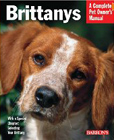
Click on the cover above
to go to this book
at Amazon.co.uk
|

Brittanys
Dan Rice
Barron's Educational Series Inc.,U.S.; 2Rev Ed edition (29 Aug 2008)
ISBN-10: 0764137727
ISBN-13: 978-0764137723
Britannys, formerly known as Brittany Spaniels have more in common with pointers than true spaniels, and the 'spaniel' part of their former name has been dropped. They are particularly useful as bird dogs, and enjoy retrieving from water. They are especially popular in their native France, as well as the US, and deserve to be better known in the UK. Brittanys tend to be smaller in France than in the US, but even in the US, they are smaller than pointers and setters, and their relatively small size makes travelling easier. They are quite easy to train, so long as owners are consistent, and usually get on well with other dogs, so they are an excellent choice for active owners who want a companion, as well as owners who want a working dog. However, Britannys do need commitment to daily walks and something interesting to do, or they can become a little neurotic, or be tempted to wander off. It is well worth investing time in advanced training with this breed, whether or not you want a hunting dog, because the rewards are so great.
Is the breed good with kids? Brittany Spaniels can find boisterous children a little overwhelming, but they are excellent companions for sensible, older children who take training seriously.
This book is a useful introduction to the breed, though it is geared more to pet owners than to people who want to hunt with Brittanys. If you want to bring out the best in your dog, it is well worth learning about the advanced skills you can teach through gundog training, while your treasure is still a pup.
 Top
of page Top
of page
|

Click on the cover above
to go to this book
at Amazon.co.uk
|

Chesapeake Bay Retriever: A Complete Handbook
Stacy Kennedy
TFH Publications
ISBN: 0793807921
Chesapeke Bay Retrievers look a little like chocolate Labs with curly
coats, though the shade is different, and Chessies are much more serious
dogs than Labs. They are strong-willed dogs, and aren't as affectionate
with strangers as Labs are, preferring to reserve their affections for
their owners and human family. They are very trainable, though it helps
to set out ground rules from when they are pups, because they can be
a bit pushy, and like to have their own way. They can perform well in
obedience activities, though don't stand as much repetition in training
as Labs can. The job they were designed to do is retrieve, which they
can do tirelessly. They enjoy swimming, and like to get muddy. Bored
chessies will tend to chew, and they need a supply of legitimate chew
objects to ensure that they don't chew your posessions. They can be
entertained with ball games, but do like to get out and about, so it's
best not to choose a Chessie unless you enjoy a daily walk.
Well trained and well socialized Chessies are generally good with children
who respect them, especially if the children play games they like, such
as retrieving. Children should always make Chessies sit before throwing
the ball, because these are such powerful dogs they can easily knock
children over. It also helps if children learn the basics of training,
so that the dog learns the same rules from all the family. Chesapeke
retrievers aren't especially playful with other dogs, and can be a little
cantankerous, but well-socialized Chessies will usually tolerate dogs
they meet on walks. Chesapeke Retrievers aren't very barky dogs, but
they are serious enough to take on the role of guard dogs. Chessies
do need extensive and ongoing socialization, even, and perhaps especially
if you want them to be guard dogs, since they have a protective and
territorial streak, and you want delivery people and visiting children
to be safe. Chessies have a powerful presence and will look serious
if they meet uninvited visitors, even after socialization - they don't
have the same open 'love everybody' character of Golden and Labrador
Retrievers. Common health problems affecting the breed include hip dysplasia,
von Willebrands, hypothyroidism and eye trouble.
Stacy Kennedy's book is a short, well illustrated guide to Chesapeke
retrievers. The history of the breed is well covered, as is their general
care and training. Anyone who wants to get the full potential from their
Chessie will need a more in-depth guide to retriever training, but this
is a good general introduction by someone who fully appreciates this
dignified breed.
 Top
of page Top
of page
|
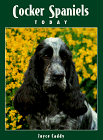
Click on the cover above
to go to this book
at Amazon.co.uk
|

The Cocker Spaniel Today
Joyce Caddy
Ringpress Books
ISBN: 1860540600
Cocker Spaniels (also called English Cocker Spaniels) can be very good
family dogs. They are not so big that they bowl children over, and the
best cockers are friendly, outgoing and tolerant of children. They take
to obedience training well, and enjoy a range of activities, including
retrieving, flyball and agility. This breed is very trainable, so long
as owners are gentle as well as firm, since Cocker Spaniels are generally
sensitive dogs. They are sometimes a little slow to housetrain, and
can put on weight easily. This may be because owners find it hard to
resist cute spaniel eyes telling them it's cold outside, or pleading
for another titbit. Fat little pups tend to turn into obese adults with
associated health problems, so it is important not to believe a fat
little pup who tries to convince you he is starving. Cocker Spaniels
need a fair amount of grooming. They like going in muddy places and
through undergrowth, where they pick up burrs and other debris. Some
Cockers can also mat easily. Many owners have their Cockers trimmed
to make grooming easier. They can also be quite barky dogs, which means
they are good watchdogs, though they are too small to be good guard
dogs.
Cocker Spaniels are often a little nippy, and they do need extensive
socialization with people, proper training and an active life to realise
their potential. Part of the trouble, however, lies in their past popularity,
which led some breeders to produce puppies with no thought for their
temperament. The problem of Cocker 'rage' persists, though there has
been a drive to eradicate this. Epilepsy is also all too common in Cockers.
The two conditions seem to be related, with some dogs suffering from
epilepsy also biting, and appearing dazed after the event. Often, though,
Cockers are nippy simply because they are cute as little pups, and not
enough effort is put into teaching them that biting people is unacceptable.
Other health problems that Cockers are vulnerable to include hypothyroidism,
hip dysplasia, eye trouble, allergies, and ear trouble. Like all dogs
with long ears Cocker Spaniels are prone to ear infections, especially
if the ears get wet on walks, so it's important to dry them properly
and protect them during baths. Hereditary deafness can also affect some
Cockers, especially those of more than one colour.
Joyce Caddy's guide to Cocker Spaniels not only covers the usual breed
history and general care, but also deals with cocker spaniels as gundogs.
There is also an illustrated guide to grooming and trimming, and the
cocker spaniel as a showdog, though anyone who just wants a Cocker to
look cute and be well groomed could perhaps think again about whether
their dog should be allowed to go out and get muddy, which is what this
breed most loves to do!
 Top
of page Top
of page
|

Click on the cover above
to go to this book
at Amazon.co.uk
|

German Shorthaired Pointers: Complete Pet Owners' Manual
Chris C Pinney
Barron's Educational Series Inc.,U.S.; 2Rev Ed edition (30 May 2008)
ISBN-10: 9780764137709
ISBN-13: 978-0764137709
ASIN: 0764137700
German Shorthaired Pointers have become more popular than English pointers,
and are generally more robust. They are affectionate and versatile dogs.
Though German Shorthairs lack the sweetness of English Pointers, being
a bit pushier and rougher looking, they are less likely to be shy in
the way that English Pointers can be, and they are still very elegant
dogs. German Shorthaired Pointers are also outdoors dogs, which need
a lot of exercise, or they can become too lively and noisy for comfort.
They like being with people, so are not good dogs to leave home alone
all day, since some can rearrange your home if they are isolated.. Owners
should be prepared to take them out every day, whatever the weather
- though it's important to regulate the exercise of pups, so they grow
properly. This breed is very trainable, though a little more patience
is needed than with a Golden or Labrador Retriever, since the breed
can be a little independent .
Are German Shorthaired Pointers good with children? Generally, yes,
though they are quite large dogs, which can easily knock small children
over. Individuals of this breed usually get on well with other dogs.
They are good watchdogs because they are quite barky, and can be wary
of strangers, but are not especially good as guard dogs. Their forte
is as versatile working gundogs, and they are good retrievers and trackers.
Pet owners can benefit from reading about the work they were designed
to do, so as to understand their pets better. Health problems that can
affect the breed include hip dysplasia, hypothyroidism, cancer, heart
disease, epilepsy, bloat, and von Willebrands, but, despite this long
list, the breed is generally healthy!
This introductory guide to the breed covers general care, behaviour,
and training, and provides a history of the breed. It is a good book
for a novice pet owner who wants to understand the potential of the
breed, though owners of working dogs are likely to want more detailed
training advice.
 Top
of page Top
of page
|

Click on the cover above
to go to this book
at Amazon.co.uk
|

German Shorthaired Pointers Today (Book of the Breed)
David Layton
Ringpress Books
ISBN: 0948955783
This is a very good breed guide for people who want their pointers
to be working dogs, or who want to understand the work that their dog
was designed to do. The book covers a lot of ground, from choosing a
puppy, and general care, to gundog training. Owners interested in shooting,
falconry, field trials, and showing their German Shorthaired Pointer
are likely to enjoy the book. It's not fully comprehensive, and some
aspects of care and training receive better coverage than others, but
experienced owners are likely to find it a source of useful tips. It
is also very well illustrated, with numerous photographs.
 Top
of page Top
of page
|
|

Working Pointers
Derek Knowles
Scotforth Books
ISBN: 1858215617
This is a very useful book for all pointer owners, not just people
who own working dogs. Pointers need to get out and about, and they do
have special training needs. You will be able to get the best from your
dog if you research what pointers are designed to do. Owners of working
pointers will also enjoy this book, and find it useful, though there
is more coverage of the German Shorthaired Pointer than the more refined
and gentle, and often underrated English Pointer.
 Top
of page Top
of page
|
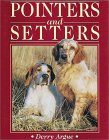
Click on the cover above
to go to this book
at Amazon.co.uk
|

Pointers and Setters
Derry Argue
Swan Hill P
ISBN: 1853102393
This is an excellent book for owners of Pointers and Setters who want
to work their dogs. There is good coverage of the way the breeds were
developed, and how their behaviour and characters are linked to the
jobs they have been designed to do. There is good advice on choosing
and raising pups, and on training dogs for work, including falconry
as well as shooting. English pointers are well covered, not just German
Shorthaired Pointers. The three Setter breeds, English, Irish and Gordon,
also get full coverage. This book is highly recommended since it covers
a lot of ground, and the author clearly knows his subject.
 Top
of page Top
of page
|

Click on the cover above
to go to this book
at Amazon.co.uk
|

The Complete Guide to the Golden Retriever
Michael Twist
McCarthy & Bassett
ISBN: 1902481089
Golden Retrievers along with Labrador Retrievers are the classic family
dog. They are generally patient, tolerant and affectionate. They tend
not to worry much about noises, or changes in their routine, unlike
Border Collies and German Shepherd Dogs, for example, which tend to
have a strong need for order. They will generally tolerate children
hugging them and otherwise expressing clumsy affection with them. They
also love playing ball games with children, Goldens need to be taught
the 'drop' command in order for them to give up retrieving objects nicely.
Goldens are a large breed, so can accidentally knock over small children
if they get too boisterous, and small children and Goldens need supervision,
because of the risk of accidents. The popularity of the breed also means
that some breeders have neglected temperament in an effort to produce
a dog that is merely saleable, so some individuals can be snappy. Generally,
however, Golden Retrievers are one of the best breeds with children.
They are also a dream to train, and are well represented in obedience
competitions. The breed retains some puppyish characteristics for quite
some time, tending to mature late, like the Labrador Retriever, but
is generally attentive and keen to please. Well-trained Goldens are
gentle with toddlers and frail elderly people alike, and they look such
happy dogs that they always seem to cheer people up. They are good confidants
for children, and provide congenial company for older people.
Golden Retrievers are also usually friendly with other dogs, though
of course they need socialization with other dogs as puppies. They tend
to bark a bit more than Labrador Retrievers, but barking is not usually
a problem if they have enough exercise. They are good watch dogs, in
the sense that they will usually bark when the doorbell rings, but then
they are likely to want to make friends with whoever comes in through
the door, so they are not good guard dogs. They can be chewers, and
need their own legitimate chew objects. They can also be droolers, and
more than one family pet has been nicknamed 'slobberchops'.
These are not low-maintenance dogs, they do need exercise, and a fair
amount of grooming, with a good towelling after muddy walks, because
the feathering on their legs, belly and tails tends to be a magnet for
mud, and they often mat behind their ears. Common health problems include
eye disorders, hip dysplasia, cancer, hypothyroidism, heart disease,
von Willebrands, epilepsy, and allergies, which may lead to skin complaints.
This book is an excellent guide to Golden Retrievers, which covers
gundog training in some detail, as well as showing, and temperament.
There is a very useful account of hereditary problems which can affect
the breed, which is refreshing, since many breed books gloss over these.
There is enough information here to interest experienced owners of Goldies,
as well as novices, who just love their dogs and have no competition
ambitions. A real treat.
 Top
of page Top
of page
|
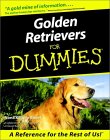
Click on the cover above
to go to this book
at Amazon.co.uk
|

Golden Retrievers for Dummies (For Dummies)
Bauer
Hungry Minds Inc
ISBN: 0764552678
This book is an enjoyable read. It gives you a clear picture of the
breed, and has a lot of good advice on the general care of Golden Retrievers.
There are also good ideas for activities to keep your dog fit and happy,
which is useful, since these are dogs which thrive on exercise and interesting
things to do.
 Top
of page Top
of page
|

Click on the cover above
to go to this book
at Amazon.co.uk
|

The Ultimate Golden Retriever
Valerie Foss
Ringpress Books
ISBN: 1860540333
This is a very well-illustrated guide to Golden Retrievers, with contributions
from a number of experts on the breed. It's a comprehensive guide, covering
everything from general care to obedience training, showing and breeding.
It is also clearly written and accessible to novices, as well as having
enough information to interest experienced Golden owners.
 Top
of page Top
of page
|

Click on the cover above
to go to this book
at Amazon.co.uk
|

Collins Dog Owner's Guide: Labrador
Dr Peter Neville
Collins; New edition edition (1 Dec 2003)
ISBN-10: 0007178328
ISBN-13: 978-0007178322
Labrador Retrievers have taken on a number of roles. They were first
developed to retrieve in water, and love swimming. They have since been
used as gundogs, and service dogs, and they are a firm favourite as
a family pet. Like Golden Retrievers, they are usually very stable and
'forgiving' dogs, tending not to be upset at changes in routine, and
tolerating novice mistakes. Like Goldens, they tend to chew a lot, especially
as pups, and need their own supply of legitimate chew toys. They aren't
as barky as Goldens, however, and don't make very good guard dogs. Any
visitor is likely to be licked, or otherwise greeted in a friendly way.
Labrador Retrievers are relatively easy to train, even though they
mature late, and can behave in puppyish ways in their early obedience
classes. They need training from when they are pups, since they are
large dogs with a sense of fun, and can get into mischief without training.
Well-trained Labrador Retrievers are ideal dogs for families with children,
so long as interactions between labs and young children are supervised,
since a bouncy lab can easily knock over a small child. They need a
daily walk or other form of exercise, or they can become too boisterous,
and are more likely to chew. They don't tend to pick up as much mud
on their walks as Golden Retrievers, though their fondness for water
does mean that they are attracted by muddy puddles. Generally, Labrador
Retrivers behave well with other dogs they meet on walks, and get on
well with other dogs in multi-dog households.
The breed comes in three colours, black, yellow and chocolate. The
most unusual are the Chocolate Labradors, and there is some prejudice
against them, though most tend to be as easy-going as the yellow and
black varieties. The main problem is that a focus on appearance can
lead to temperament and health being put second and third. This can
be a problem if breeders deliberately seek to produce Chocolate Labs,
rather than healthy, nice-natured Labs.
Labrador Retrievers are not especially barky, and don't need much grooming.Common
health problems include hip dysplasia and eye disorders. Arthritis is
also common in older Labrador Retrievers. This is often exacerbated
by obesity, since the breed has a very strong food drive, good for motivating
them in training, but it makes it difficult to keep them slim. They
will tend to wolf any old rubbish they find in the street, 'counter
surf', or raid kitchen surfaces for food, and raid rubbish bins for
scraps. However they are not fussy eaters! Owners of spayed bitches
in particular need to keep a very close watch on their weight. They
can also suffer from ear infections due to their love of water, and
their ears need regular checks, and should be dried after the Lab has
been swimming. Labrador Retrievers are also vulnerable to cancer, heart
disease, hypothyroidism, seizures, von Willebrands, and allergies, including
those that give rise to skin and nail complaints.
Peter Neville is one of the UK's top behaviourists, and here he has
produced a concise guide to Labs that will be invaluable for first-time
owners. This guide explains their breed characteristics, and gives help
with general care and first aid, as well as help with training and not-so-welcome
behavioural quirks. Excellent value, and best bought before you get
your Lab, so that you are well-prepared.
 Top
of page Top
of page
|
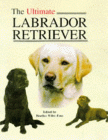
Click on the cover above
to go to this book
at Amazon.co.uk
|

The Ultimate Labrador Retriever
Heather Wiles-Fone
Ringpress Books
ISBN 1 86054 022 8
There is a great deal of information in this guide to labs, enough
to satisfy experienced owners, as well as novices. The breed's history
is covered, as well as all aspects of general care and health. There
is advice on training - important for a large dog, even one that's usually
as reliable as a Labrador in terms of temperament. The advice includes
help for those wanting to work their dogs, as gundogs, and for those
who want to show their Labradors. The book is well-illustrated, with
photos that will delight fans of this good-natured, versatile breed.
 Top
of page Top
of page
|
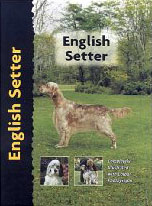
Click on the cover above
to go to this book
at Amazon.co.uk
|

English Setter
Juliette Cunliffe
Interpet Publishing
ISBN: 1903098718
English Setters are very elegant dogs, with flecked or solid coats.
They are high-maintenance dogs, needing a lot of grooming and exercise.
English Setters tend not to be as skittish as Irish Setters, though
neither are they as calm as Gordon Setters. All three setter breeds
are good at scenting game, and are active dogs that need a few miles
walk every day, or they are likely to become difficult. They are not
entirely trustworthy off leash, since they like to follow scents, so
they should only be let off well away from traffic. Generally, all three
types of Setter are affectionate, and good with both children and other
dogs, though they are quite large, and can easily knock children over,
so small children and Setters need supervision. Rough games should also
be discouraged from when they are pups, as should jumping up. Bloat
can be a problem for setters, as with any large breed dog, and hip dysplasia
can also affect the breed. English setters which are white are more
likely to suffer from skin problems, such as allergies.
This is a very good introductory guide to the breed, which is clearly
written, and gives good coverage of the basics such as the history of
the breed, breed characteristics, general care and training, and it
is well illustrated.
 Top
of page Top
of page
|
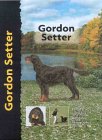
Click on the cover above
to go to this book
at Amazon.co.uk
|

Gordon Setter (Pet Love)
Lavonia Harper
Interpet Publishing
ISBN: 1903098696
Gordon Setters are black and tan setters which are very similar to
Irish and English Setters, though Gordons are generally more robust,
less skittish, and need a little less grooming because their coats are
not so long. Gordons are sometimes passed by in favour of their more
elegant cousins, the English and the Irish Setters, but they have a
lot to recommend them. They are generally the easiest of the setters
to train because they are calmer, while sharing the affectionate nature
of the other two breeds. Gordons are still high-energy dogs needing
a lot of exercise, and training does require patience and persistence.
Recall can be a problem, so they need a lot of practice in this from
when they are pups in your garden, and a safe area, well away from traffic,
in order to run off leash.
Setters are good retrievers, and enjoy playing ball games, though they
need to be taught to sit before you throw the ball, so they don't get
overenthusiastic. They can be very good with children, because they
are an affectionate breed, though they are a little too lively for smaller
children. It's important to teach them to greet people with all four
paws on the ground from when they are pups. They can be quite barky,
especially if they don't have enough exercises. They are good watchdogs,
but can be very affectionate with strangers, and don't make good guard
dogs. Common health problems include hip dysplasia, bloat, hypothyroidsim
and eye trouble.
This guide to Gordon Setters is book is well illustrated, and covers
the history and character of Gordons, as well as the breed standard.
There is also advice on training and general care, including health
care. It is a good introductory guide, though there is little to interest
more experienced owners, apart from the nice pictures!
 Top
of page Top
of page
|
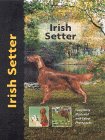
Click on the cover above
to go to this book
at Amazon.co.ukv
|

Irish Setter (Pet Love)
Margaret Williams
Interpet Publishing
ISBN: 1902389301
Irish Setters are exceptionally elegant dogs, which perform well in
the show ring, but a focus on their looks has not done a lot for their
temperaments. Some individuals can be very skittish and over-sensitive,
which can make them difficult to train and walk, though they are an
affectionate breed. Irish Setters at their best can be a handful to
train. They benefit from a firm, but gentle approach, with short, daily
training sessions from when they are pups. Like English Setters and
Gordon Setters, Irish Setters are active dogs that need a few miles
walk every day, and, like English and Gordon Setters, Irish Setters
are not entirely trustworthy off leash, since they like to follow scents,
so they should only be let off well away from traffic. They like ball
games, once you have taught them how to play ball, so you can train
recall in your garden, using a ball as a lure to get them to come back
to you. It's safer to ask them to sit, and only throw the ball when
they are sitting, so they don't jump up in their excitement. Like English
and Gordon Setters, Irish Setters are generally good with both children
and other dogs, though they are quite large, and can easily knock children
over, so small children and Setters need supervision. Irish Setters
also need to learn to greet people with all four paws on the ground,
since they can easily knock over children or frail adults if they jump
up.
Irish Setters are higher-maintenance than Gordons, in that their longer
coats need daily grooming, and collect more mud on those walks. The
breed can be quite barky, so Irish Setters can make good watchdogs,
but they are generally either too friendly or skittish to be good guard
dogs. Common health problems include hip dysplasia, hypothyroidism,
epilepsy, allergies, and eye trouble.
This book is a very good introductory guide to Irish Setters, which
gives help with training, as well as covering the history of the breed,
and the breed standard. There is also advice on choosing an Irish Setter,
and on general care. The book is very well illustrated. It is more likely
to interest new owners than people who already have experience of the
breed.
 Top
of page Top
of page
|

Click on the cover above
to go to this book
at Amazon.co.uk
|

English Springer Spaniel
Haja van Wessem
Interpet Publishing
ISBN: 1902389263
English Springer Spaniels can be very rewarding dogs for people who
appreciate them, give them proper training and enough exercise. They
are not as easy for a novice to take on as Welsh Springers or Cocker
Spaniels. They need a more active life than Cockers if they are not
to develop behavioural problems, and are bigger, and more prone to health
and behavioural problems than Welsh Springers.. They have a higher than
average risk of being killed in road traffic accidents, whereas the
risk for Cockers is lower than average. Springers also have a higher
than average risk of being euthanased for behavioural problems. The
main problem is that they are essentially working dogs. Untrained Springers
who only get to see their back gardens can be very difficult to live
with, becoming overactive and destructive. English Springer Spaniels
are also more prone to being pushy to get their own way than are Welsh
Springers, and this can create serious problems with adolescent dogs.
It's especially important with this breed to be firm and consistent,
from when they are little pups. If you don't want a muddy adult Springer
on your sofa, don't allow the pup up there! Make sure the dog sits before
you open the door to let him out. This helps later, because they are
quite strong dogs and adults can pull you out of the door, not giving
you time to close it!. English Springers are also a bit more likely
than average to pick fight with other dogs, especially those of the
same sex, despite socialization with other dogs, though this is not
inevitable, and many get on fine with other dogs they meet on walks.
Springers that have enough exercise tend to get on better with other
dogs. English Springer Spaniels can be trained to a high level, however,
so long as you start from puppyhood. Well-bred and well-trained English
Springers are friendly and affectionate.
Exercise is essential for this breed. English Springers that don't
get out enough tend to be overactive, destructive and barky. They need
to be able to run off leash, which usually means taking them somewhere
quite wild and muddy. They are not dogs to take to parks with ornamental
waterfowl, which they will chase. They are naturally good swimmers,
and enjoy getting wet and muddy. They should be called now and then
when off leash, so that they remember they are with their owners. Owners
can benefit enormously from reading specialist books on how to train
Springers and allow them to retain their hunting instincts while having
some degree of recall. These dogs are good retrievers, so you can wear
them out with ball games in an emergency. Ball games can also be useful
for distracting them from other dogs if you fear they may misbehave.
English Springer Spaniels which get on with other dogs can do very well
in agility. They also like playing sniffer dog games, and are good trackers.
Springers can be good watchdogs, and will bark to give the alarm when
someone comes to the door, but they are generally friendly with strangers,
so are not good guard dogs.
Are English Springer Spaniels good with children? This depends. They
are a little too strong and lively for children to take on walks, their
temperament can vary, and socialization, training and exercise are important.
They are, however, outgoing and affectionate by nature, so well-bred
and well-trained English Springers can be very good companions for older
children.
English Springer Spaniels tend to have longer hair so need a little
more grooming than Welsh Springers, though both have a propensity for
coming back muddy and full of burrs. They need a good towelling after
a muddy walk, including their ears, and can then be allowed to dry before
having the burrs and other debris brushed out.
Common health problems include hip dysplasia, eye trouble, von Willebrands
disease, skin complaints, phosphofrutokinase deficiency, and epilepsy,
which can be linked to Springer Rage. Rage is an inherited condition,
involving quite nasty attacks, with the dog often dazed afterwards.
Get your dog to a vet if you think that he could be affected, since
this condition can, in some cases, be treated with medication. Often,
though, English Springers which snap don't actually have Rage, and are
just being pushy and snappy to try to get their own way, so you need
a diagnosis to see whether medical treatment or a change in training
regime is indicated. Other common health problems include ear infections,
which tend to affect breeds with long ears. Their ears should be checked
regularly and cleaned when necessary, and not allowed to stay wet after
the Springer has been in water.
This book is a useful guide to the breed, which is detailed enough
to interest experienced owners as well as novices. It's well-written
and well illustrated. Owners may still need some more help with training
these dogs than this book offers.
 Top
of page Top
of page
|

Click on the cover above
to go to this book
at Amazon.co.uk
|

The Welsh Springer Spaniel (The World of Dogs)
Anne Walton
Kingdom Books
ISBN: 1852791128
Welsh Springer Spaniels are slightly smaller than English Springers,
and have rich red, rather than liver markings. They are a little bigger
than Cockers, and a better bet than either English Springers or Cockers
in some ways. They tend to have fewer behavioural and health problems
than English Springers, which are generally more active, and more prone
to inherited diseases. Epilepsy, and unexplained rage are more common
in English Springers. Cockers vary in terms of temperament, and some
are relaxed individuals, while others are nippy, with a few suffering
from epilepsy and sudden, unexplained aggression. Welsh Springers tend
to be free of these problems, though they are only suitable for people
who lead very active lives. Welsh Springers need a long walk every day,
with plenty of time off leash, or they can become overactive and destructive.
They are a sometimes a little shy of people they don't know, so need
ongoing socialization with people. They can be barky, and make good
watchdogs, though they are not good guard dogs, since they are quite
small and usually like people. A Welsh Springer will give a warning
bark, but then could easily make friends with an intruder who said hello
to them in a friendly way! They tend to get on better with other dogs
than do English Springers.
Welsh Springer Spaniels are more easily trained than English Springers,
and are attentive to their owners, though they can get confused if owners
lose their patience and shout at them. They are designed to be working
dogs, and will sometimes forget training in recall if they pick up a
scent, and are not dogs to let loose in city parks with ornamental wildfowl.
They need to be allowed to run off leash, but should be called now and
then, so that they remember they are with their owners. Owners can benefit
enormously from reading specialist books on how to train Springers and
allow them to retain their hunting instincts while having some degree
of recall.
This breed tends to be a good companion with children, so long as the
dog has enough exercise - underexercised Welsh Springers can be too
overactive for many children. However, children can be included in their
exercise programme, teaching to dog to retrieve in the garden. Welsh
Springers also like to play sniffer games, finding a hidden object by
smell.
Hip dysplasia and eye trouble can affect this breed, and epilepsy is
not unknown, just much less common than in Cockers and English Springers.
They are also prone to ear infections, which tend to affect breeds with
long ears. Their ears should be checked regularly and cleaned when necessary,
and not allowed to stay wet after the Springer has been in water.
These dogs do need regular brushing, especially because they like to
go in muddy places, and collect burrs on their coats. It is useful to
have a towel ready after their walks, because their feathery parts tend
to pick up a lot of mud. They can be brushed to get rid of debris in
their coats once they are dry.
This is a comprehensive guide to Welsh Springer Spaniels with enough
detail to interest those who already know a lot about the breed. It
has a lot of useful advice on all aspects of keeping Welsh Springers,
and is very well illustrated. It is also very well written, and the
author's enthusiasm for the breed is very clear.
 Top
of page Top
of page
|

Click on the cover above
to go to this book
at Amazon.co.uk
|

The Working Springer Spaniel
Keith Erlandson
Swan Hill Press; 2Rev Ed edition (7 Jan 2003)
ISBN-10: 9781904057185
ISBN-13: 978-1904057185
ASIN: 1904057187
This is a very useful, authoritative and comprehensive guide for owners
of working Springer Spaniels by someone who knows and loves these dogs.
Springer Spaniels are designed to be working dogs, and need active lives.
This is also a useful book for pet owners who want to know what their
dog is capable of, and how to get the best out of and achieve a full
life for their Springer Spaniel.
 Top
of page Top
of page
|

Click on the cover above
to go to this book
at Amazon.co.uk
|
The Hungarian Vizsla (The World of Dogs)
Gay Gottlieb
Kingdom Books
ISBN: 1852791047
Hungarian Vizslas are elegant pointers, which have also been used as
retrievers. They are active, affectionate dogs, who both like daily
walks with their owners, and need company - they like to follow their
owners round the house. They do involve a big commitment because of
their need for company and exercise. They are good retrievers, and can
learn to retrieve in your garden, so that they can be given ball games
in an emergency if you are unable to take them out.. They are quite
easy to train, because they are affectionate and want to please, and
they can take part in a range of activities, including agility. Vizslas
are generally good with children, though, as a relatively large breed,
they can knock small children over, especially when they are younger
and more boisterous. Vizslas also generally get on well with other dogs.
They don't need much grooming, but they can be quite barky.
Common Vizsla health problems include sensitivity to chemicals, including
veterinary pharmaceutical products such as anaesthetics, and they are
also prone to hip dysplasia, cancer, hypothyroidism, von Willebrands,
eye trouble, and seizures. Vizslas also tend to feel the cold, and may
be a little reluctant to go for last night walks without a coat, on
really nasty nights!
This book is an updated version of a classic text on Vizslas. It is
full of sensible advice for anyone considering a Vizsla puppy, as well
as tips for new and experienced owners. There is comprehensive coverage
of all aspects of Vizsla ownership, including gundog training and ringcraft.
It's also a very well illustrated guide to the breed.
 Top
of page Top
of page
|

Click on the cover above
to go to this book
at Amazon.co.uk
|

The Weimaraner: An Owner's Guide to a Happy Healthy
Pet
Riley
Hungry Minds Inc
ISBN: 1582451710
Weimaraners are perhaps the most challenging of the gundog breeds.
They are very elegant dogs, with a sleek body, silver-grey coat, and
pale eyes. Their looks alone give them immense appeal, and well-trained
Weims are also bold and friendly. They do need training, and the house
rules should be clearly explained to them from when they are pups. They
are very strong dogs, and know their own minds. Weimaraners are among
the breeds with a higher than average risk of being euthanased for behavioural
problems, perhaps because too many owners bought pups for their striking
good looks, and did not realise the commitment needed in training them.
Luckily, they are quite easy to train, so long as they are taught acceptable
behaviour as soon as they arrive as pups. A very short session of formal
training every day is also helpful, while they are puppies, as well
as the usual puppy socialization and obedience classes. Anyone planning
to train their own dog would do well to invest in a good training manual,
and ensure that their Weim meets a lot of other dogs and people, in
order to learn good manners.
Weimaramers also involve a commitment in terms of walks - they need
regular exercise, or they tend to become difficult to live with, overactive
and barky. They do enjoy retrieving, however, once they have been taught.
It's safer to ask them to sit before the ball is thrown, so they don't
jump up. They can excel in obedience work and field trials. Well-trained
Weimaramers are generally good with children and other dogs. Untrained
Weims are not! They are likely to knock children over and generally
be a pain. They don't need much grooming, and are generally healthy
as a breed, though not especially long-lived. Common health problems
include a higher than average risk of spay-related incontinence. Other
health problems that Weimaraners are vulnerable to include cancer, bloat,
hypothyroidism, hip dysplasia, von Willebrands, and eye and skin complaints.
This is a good general introduction to Weimaraners which is aimed at
a US audience. It is well-illustrated, and well set out, and covers
the basics which a novice Weimaraner owner needs to know.
 Top
of page Top
of page
|
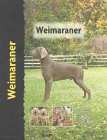
Click on the cover above
to go to this book
at Amazon.co.uk
|

Weimaraner (Pet Love)
Lavonia Harper
Interpet Publishing
ISBN: 1902389093
Lavonia Harper is obviously a great devotee of the Weimaraner and from
this book; I would guess that she particularly specialises in the fields
of showing and obedience.
Being a weimaraner owner myself, I enjoyed reading about the history
of the breed and found myself smiling and nodding in recognition throughout
the ‘characteristics of the weimaraner’ chapter. The weimaraner
certainly has a very strong personality, and not a breed to be considered
unless you can appreciate their strong hunting and tracking instinct,
and that your weimar will more than likely catch, kill and eat rabbits
and possibly squirrels, foxes, deer and fowl. You will need to work
very hard to ensure that they don’t chase cats, horses, sheep and
other farm animals too.
“Weimaraner” covers all aspects of living with a weimaraner
as a pet and show dog. It is beautifully illustrated with photographs
of both the long and shorthair weimaraner, and gives good basic coverage
of everything from finding a good breeder and choosing a puppy; basic
puppy training; grooming and general health care, basic training, parasites
(some of the pictures here are quite alarming and maybe not for the
squeamish); disease in the Weimar; old age and then on to hobbies and
sports that you might like to participate in.
Although this book looks at training with sympathy for a deeply sensitive
yet wilful and sometimes quite independent breed, I would recommend
that for a new puppy owner you also look to a book that specialises
in motivation and reward training, which given their intelligence, the
weimaraner takes to particularly well.
As a first introduction to the breed, I would suggest that this book
is more likely to make you want a weimaraner than to fully appreciate
how difficult they can be but given that most breed books tend to be
very biased towards the breed of their author’s choice, I felt
that it covered the character and hunting instinct quite honestly.
From a personal point of view, although I appreciate that the majority
of breeders are strongly in favour of traditional tail docking and this
book seems to be of no exception, it is illegal in much of Europe and
may well soon be over here too so I would have liked to have seen a
few pictures of full tail dogs. There are good breeders who do not tail
dock and if you prefer to see a dog with a natural tail, it is well
worth investing the little more time and effort to find such a breeder.
You can get further information from: www.anti-dockingalliance.co.uk
For a greater understanding on what the more challenging aspects of
actually living with a weimaraner mean in everyday life, I would urge
anyone considering this breed to join the weimaraner forum: www.weimaranerforum.org
If you are more interested in field sports and working with your Weimar
as a gundog, this book might not be your first choice but if you are
a fan of the breed and enjoy reading about them, you will love this
book.
Review by Diana Attwood.
 Top
of page Top
of page
|
|

The Essential Weimaraner (Book of the Breed)
Patsy Hollings
Ringpress Books
ISBN: 1860540910
Patsy Hollings is a specialist in Weimaraners, and her account of the
breed is very funny at times, as well as being a source of practical
advice. This guide covers the breed's history, and gives help with all
aspects of Weimaraner ownership, from choosing a pup, to showing and
field trials. It's well-illustrated, with some wonderful photos of Weims,
and is likely to be of interest to experienced owners, as well as novices
with their first Weim.
 Top
of page Top
of page
|

Click on the cover above
to go to this book
at Amazon.co.uk
|

Gun-dog Training: Spaniels and Retrievers
Kenneth C. Roebuck
Stackpole Books
ISBN: 0811707784
This is a very useful training manual for owners of gundogs. It is
full of ideas and tips, and is essentially a practical book which is
especially suitable for people training their own working dogs. You
may not like all the methods described, but you can pick and choose,
and decide whether you agree with the rationale behind the suggestions
that Roebuck proposes, adapting some of his suggestions to suit your
own training style. The author clearly loves gundogs, and both experienced
and novice owners of working dogs can benefit from his expertise.
 Top
of page Top
of page
|

Click on the cover above
to go to this book
at Amazon.co.uk
|

Training Spaniels
Joe Irving
Swan Hill P
ISBN: 1853104191
This is a clearly written guide to training spaniels as gundogs which
covers the first working season, as well as working dog field trials.
There is also help with the general care of spaniels at all stages of
their lives. This is suitable for novice owners, and for more experienced
owners who want to improve their training methods in order to be able
to compete with their dogs.
 Top
of page Top
of page
|
See also:
 Dogs:
Breed profiles and breed books Dogs:
Breed profiles and breed books
 Dogs:
Health and Nutrition Dogs:
Health and Nutrition
 Dogs:
General Dogs:
General
 Dogs:
Origins, canine evolution and wolves Dogs:
Origins, canine evolution and wolves
 Training, puppy and adult dog good manners Training, puppy and adult dog good manners
 Fiction
and biography relating to dogs Fiction
and biography relating to dogs
 Books on falconry Books on falconry
 Click
here to see some of your favourite breeds on stamps Click
here to see some of your favourite breeds on stamps
|